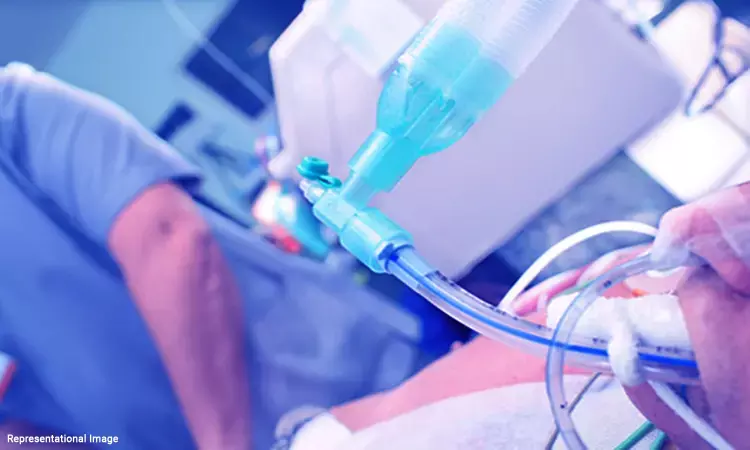- Home
- Medical news & Guidelines
- Anesthesiology
- Cardiology and CTVS
- Critical Care
- Dentistry
- Dermatology
- Diabetes and Endocrinology
- ENT
- Gastroenterology
- Medicine
- Nephrology
- Neurology
- Obstretics-Gynaecology
- Oncology
- Ophthalmology
- Orthopaedics
- Pediatrics-Neonatology
- Psychiatry
- Pulmonology
- Radiology
- Surgery
- Urology
- Laboratory Medicine
- Diet
- Nursing
- Paramedical
- Physiotherapy
- Health news
- Fact Check
- Bone Health Fact Check
- Brain Health Fact Check
- Cancer Related Fact Check
- Child Care Fact Check
- Dental and oral health fact check
- Diabetes and metabolic health fact check
- Diet and Nutrition Fact Check
- Eye and ENT Care Fact Check
- Fitness fact check
- Gut health fact check
- Heart health fact check
- Kidney health fact check
- Medical education fact check
- Men's health fact check
- Respiratory fact check
- Skin and hair care fact check
- Vaccine and Immunization fact check
- Women's health fact check
- AYUSH
- State News
- Andaman and Nicobar Islands
- Andhra Pradesh
- Arunachal Pradesh
- Assam
- Bihar
- Chandigarh
- Chattisgarh
- Dadra and Nagar Haveli
- Daman and Diu
- Delhi
- Goa
- Gujarat
- Haryana
- Himachal Pradesh
- Jammu & Kashmir
- Jharkhand
- Karnataka
- Kerala
- Ladakh
- Lakshadweep
- Madhya Pradesh
- Maharashtra
- Manipur
- Meghalaya
- Mizoram
- Nagaland
- Odisha
- Puducherry
- Punjab
- Rajasthan
- Sikkim
- Tamil Nadu
- Telangana
- Tripura
- Uttar Pradesh
- Uttrakhand
- West Bengal
- Medical Education
- Industry
Prevention strategies of Ventilator-associated pneumonia and NV-HAP released by SHEA/IDSA/APIC

Recent guidance document provides practical advice to aid acute-care hospitals in prioritising and implementing methods to reduce ventilator-associated pneumonia (VAP), ventilator-associated events (VAEs), and nonventilator hospital-acquired pneumonia (NV-HAP) in adults, children, and neonates.
The Society for Healthcare Epidemiology (SHEA) sponsored this expert guideline paper, which is the result of a joint effort headed by SHEA, the Infectious Diseases Society of America, the Association for Professionals in Infection Control and Epidemiology, the American Hospital Association, and The Joint Commission, with significant contributions from members of a number of organisations and societies with topic expertise.
Recommendations are divided into two categories: "basic practises" that should be implemented by all acute-care hospitals, and "additional methods" that may be explored for use in specific areas and/or populations within hospitals if essential practises do not reduce HAIs.
Essential practices
To avoid intubation, shorten the period of intubation, and eliminate reintubations, a recommendation for high-flow nasal oxygen or noninvasive positive pressure breathing was included.
A suggestion for spontaneous waking trials or sedation protocols as effective ways for reducing sedation in adults was included.
Endotracheal tubes with subglottic secretion drainage were reclassified from an Essential Practice to an Additional Approach, and a daily toothbrushing guideline was added.
Caffeine treatment was included as a suggestion for facilitating extubation in preterm newborns.
Additional approaches
Endotracheal tubes with subglottic secretion drainage have been reclassified as an optional rather than mandatory procedure for adults and older children.
In patients at high risk for aspiration, a suggestion to seek early tracheostomy was included, as well as a recommendation to explore postpyloric rather than stomach feeding.
Not recommended
Probiotics
oral care with chlorhexidine
Endotracheal tube cuffs made of ultra-thin polyurethane
Cuffs for endotracheal tubes that are tapered
Endotracheal cuff pressures automatically controlled.
Endotracheal cuff pressure monitoring on a regular basis.
Recommendations to prevent NV-HAP
Interventions that may lower NV-HAP rates with little risk of harm
Maintain regular oral hygiene - Oral hygiene is the most well researched therapy for preventing NV-HAP.
NV-HAP may be avoided if dysphagia is diagnosed and treated early, particularly in neurologically compromised post-stroke patients.
Assist with early mobilisation
Implement multimodal interventions to prevent viral infections - Symptom screening of patients and healthcare workers, surveillance testing of all admitted patients, transmission-based precautions for patients with suspected and confirmed respiratory viral infections, universal masking when respiratory virus transmission rates are high in the hospital or community, assuring adequate ventilation are all possible strategies to prevent nosocomial viral transmission.
Approaches not generally recommended for routine NV-HAP prevention
Systemic antibiotic prophylaxis - Prophylactic antibiotics have had no effect on pneumonia incidence, functional prognosis, or death in acute stroke patients in randomised studies.
Reference -
Klompas, M., Branson, R., Cawcutt, K., Crist, M., Eichenwald, E., Greene, L., . . . Berenholtz, S. (2022). Strategies to prevent ventilator-associated pneumonia, ventilator-associated events, and nonventilator hospital-acquired pneumonia in acute-care hospitals: 2022 Update. Infection Control & Hospital Epidemiology, 1-27. doi:10.1017/ice.2022.88
MBBS, MD (Anaesthesiology), FNB (Cardiac Anaesthesiology)
Dr Monish Raut is a practicing Cardiac Anesthesiologist. He completed his MBBS at Government Medical College, Nagpur, and pursued his MD in Anesthesiology at BJ Medical College, Pune. Further specializing in Cardiac Anesthesiology, Dr Raut earned his FNB in Cardiac Anesthesiology from Sir Ganga Ram Hospital, Delhi.
Dr Kamal Kant Kohli-MBBS, DTCD- a chest specialist with more than 30 years of practice and a flair for writing clinical articles, Dr Kamal Kant Kohli joined Medical Dialogues as a Chief Editor of Medical News. Besides writing articles, as an editor, he proofreads and verifies all the medical content published on Medical Dialogues including those coming from journals, studies,medical conferences,guidelines etc. Email: drkohli@medicaldialogues.in. Contact no. 011-43720751


